Related Research Articles

Georg Friedrich Puchta was an important German Legal scholar.

Mining law is the branch of law relating to the legal requirements affecting minerals and mining. Mining law covers several basic topics, including the ownership of the mineral resource and who can work them. Mining is also affected by various regulations regarding the health and safety of miners, as well as the environmental impact of mining.
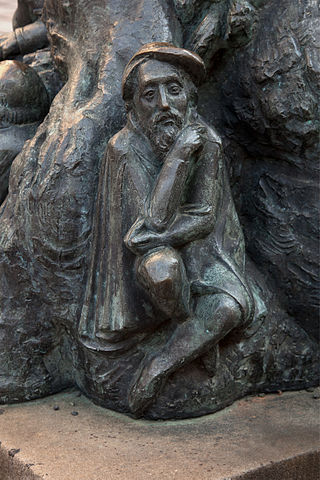
Ulrich Rülein von Calw (1465–1523) was a doctor, mathematician and well-known mining engineer. He was also active as a surveyor, town planner and astrologer and was the mayor of the mining town of Freiberg for five years.

A Kunstgraben is a type of man-made water channel that was once used by mines to drive the water wheels needed for power, mine drainage and a host of other purposes. The term is German. Similar ditches supplying water mills in England are called leats.
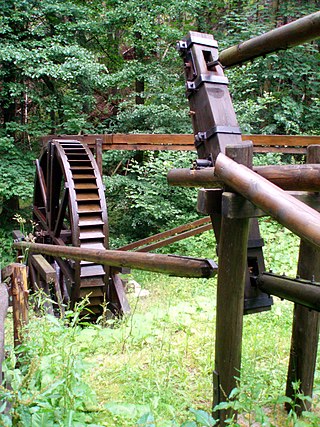
The flatrod system was an invention of the mining industry that enabled the mechanical movement generated by a water wheel to be transferred over short distances. It was invented in the 16th century and by the 18th century was being used to transmit power up to four kilometres. Flatrod systems were widely used in the Harz and Ore Mountains of Germany as well as in Cornwall, England and Bergslagen in Sweden.

A Rösche is a German mining term that refers inter alia to a gullet (Wasserseige), a trench for draining water in the lower part of a mine gallery. In order to keep the actual gallery entrance (Stollenmundloch) free and guard against backflooding the Röschen were, in many cases, extended to below the entrance or led even further away, underground, to the nearest stream or river.
The Revierwasserlaufanstalt Freiberg or RWA Freiberg, was a historical water management system that delivered driving water to the Freiberg mines in the time of the German Electorate and later Kingdom of Saxony. Today the system is used to supply drinking and industrial water and is operated by the Saxony State Reservoir Office.
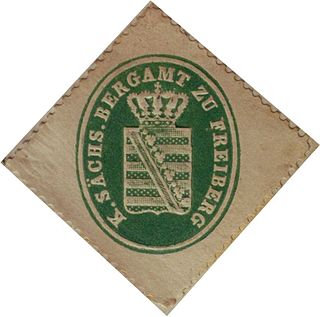
The Saxon Mining Office is the executive authority for mining rights in the German state of Saxony. It is also responsible for all non-metallic mineral resources on the terrain of the former East Germany.

Glückauf is the traditional German miners' greeting. It describes the hope of the miners: "es mögen sich Erzgänge auftun" which is short for "Ich wünsche Dir Glück, tu einen neuen Gang auf", because, when mining for ore, without prospecting, no-one could predict with certainty whether the miners' work would lead to a reward. The greeting also expressed the desire that miners would return safely from the mine after their shift.
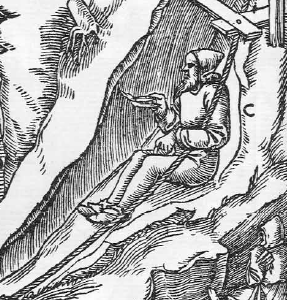
The miner's apron is part of the clothing worn, especially historically, by miners in the mining industries of German-speaking Europe. Variously called in English a miner's apron, a miner's after-apron, breech leather or miner's leather apron, it was a leather apron that served to keep the seat of the trousers from wearing out when working or moving around the mine (Fahrung) as well as keeping out the cold and moisture when sitting. It also provided protection especially when entering inclined mineshafts. Another advantage was that it stabilised the internal organs from mechanical shock and vibration by acting as a sort of kidney belt. The miner's apron was a triangular or, more rarely, semi-circular piece of leather and was supported by the body belt. In Germany the design of the modern miner's apron is governed by DIN standard 23307 Gesäßleder für den Bergbau (Arschleder).

A Steiger is the title of a mining foreman or mine manager, used in German-speaking Europe. He bears responsibility for part of the mine and the people subordinated to him. The name is derived from the former role of a Steiger, who continually had to climb into and out of the pit. The Steiger is celebrated in a very popular German mining song the so-called Steigerlied.

The Mooskappe is an old, traditional miners head covering. It was intended to protect miners when working underground from the impact of small rockfalls and from hitting their heads against the gallery roof (Firste). The term is German and this type of hat was worn especially in the Harz Mountains of Germany.

The Bergregal was the historic right of ownership of untapped mineral resources in parts of German-speaking Europe; ownership of the Bergregal meant entitlement to the rights and royalties from mining. Historically, it was one of those privileges that constituted the original sovereign rights of the king.

The Bergordnung were the mining regulations or law enacted in order to exercise the royal mining rights or Bergregal in central Europe in medieval times.

The German Mining Museum in Bochum or DBM is one of the most visited museums in Germany with around 365,700 visitors per year (2012). It is the largest mining museum in the world, and a renowned research establishment for mining history.
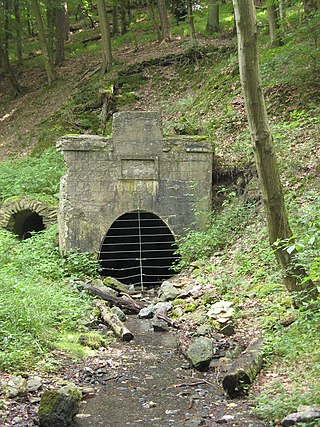
Pit water, mine water or mining water is water that collects in a mine and which has to be brought to the surface by water management methods in order to enable the mine to continue working.

A hewer is a miner who loosens rock and minerals in a mine. In medieval mining in Europe a Hauer was the name given to a miner who had passed his test (Hauerprüfung) as a hewer.
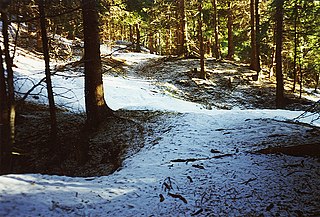
A Pinge or Binge ("binger") is the name given in German-speaking Europe to a wedge-, ditch- or funnel-shaped depression in the terrain caused by mining activity. This depression or sink-hole is frequently caused by the collapse of old underground mine workings that are close to the Earth's surface. Unlike natural landforms, a Pinge is a direct result of human activity. The term has no direct equivalent in English, but may be translated as "mining sink-hole", "mine slump" or, in some cases, as "glory hole".

Stolberg Zinc joint-stock company for mining and smelter operations in Aachen, or Stolberg Zinc Mines GmbH, is a metal mining concern in the Aachen region and specifically in the area of Eschweiler-Stolberg, with headquarters in Stolberg.

The area around Wiesloch, Germany, is a historical centre for mining, running between Roman times and the earlier 2000s. The area is situated on the eastern edge of the Upper Rhine Plain and contains large concentrations of carbonate-hosted lead-zinc ore deposits. Lime for cement is still actively mined in the vicinity, with most of the clay pits closed, and the last heavy metal mine operated until 1953 by Stolberger Zink. On top of the escarpment metals and lime have been mined, with clay and sand mined at the end of the valley floor where faulting has brought different layers closer to the surface.
References
- 1 2 Heinrich Veith: Deutsches Bergwörterbuch mit Belegen. Verlag von Wilhelm Gottlieb Korn, Breslau 1871, p. 78, 291–293.
- 1 2 3 Carl von Scheuchenstuel: IDIOTICON der österreichischen Berg- und Hüttensprache. k. k. Hofbuchhändler Wilhelm Braumüller, Wien 1856.
- 1 2 3 Carl Hartmann (ed.): Handwörterbuch der Berg-, Hütten- u. Salzwerkskunde der Mineralogie und Geognosie. Vol. 1 (A to F), 2nd fully revised edn.,, Buchhandlung Bernhard Friedrich Voigt, Weimar 1859.
- 1 2 3 Carl Hartmann: Handwörterbuch der Mineralogie, Berg-, Hütten- und Salzwerkskunde. Part 1 (A to K), printed and published by Bernhard Friedrich Voigt, Ilmenau 1825.
- ↑ Georg Schreiber: Der Bergbau in Geschichte, Ethos und Sakralkultur. Springer Fachmedien GmbH, Wiesbaden 1962, ISBN 978-3-663-00242-0, S. 397.
- ↑ Adolf Arndt, Kuno Frankenstein (ed.): Hand- und Lehrbuch der Staatswissenschaften in selbständigen Bänden. Erste Abteilung Volkswirtschaftslehre XI. Band, Bergbau und Bergbaupolitik, Verlag von C.L. Hirschfeld, Leipzig 1894, pp. 32–37.
- ↑ Friedrich August Schmid (ed.): Deutsche Bergwerks-Zustände, eine Charakteristik der Bergwerks-Verfassung Deutschlands mit Hinweisung auf ihre Mängel und ihre Bedürfnisse. In Commission der Kori'schen Buchhandlung, Dresden 1848, pp. 132–154.
- 1 2 Swen Rinmann: Allgemeines Bergwerkslexikon. Part 1, Fr. Chr. W. Vogel, Leipzig 1808.
- 1 2 Christian Heinrich Gottlieb Hake: Commentar über das Bergrecht mit steter Rücksicht auf die vornehmsten Bergordnungen, verbunden mit der für den Juristen nothwendigen Technik. Kommerzienrath J. E. von Seidel Kunst- und Buchhandlung, Sulzbach im Regenkreise Baierns 1823, S. 74–80.
- 1 2 Berg- und hüttenmännischer Wegweiser durch Ober-Schlesien: Ein Handbuch sowohl für gebildete Reisende aller Art, als zum Selbststudium zunächst für Berg- und Hüttenleute, besonders vom Eisenhütten-Fache, dann aber auch für Technologen, Kameralisten, Staatswirthe und Freunde der Industrie; Part 1, in der Hande- und Spenerschen Buchhandlung G. J. Joseephy, Berlin 1828, pp. 1–4.
- ↑ Ministerium für Handel, Gewerbe und öffentliche Arbeiten (ed.): Zeitschrift für das Berg-, Hütten- und Salinenwesen in dem preußischen Staate. Verlag der königlichen geheimen Ober-Hofdruckerei R. Decker, Berlin 1858, pp. 1–8.
- 1 2 Rudolph Manger (ed.): Das Oesterreichische Bergrecht nach dem allgemeinen Berggesetze für das Kaiserthum Oesterreich vom 23. Mai 1854. Verlag der k. k. Hof-Buch- und Kunsthandlung F. A. Credner, Prag 1857, S. 20–23.
- ↑ Gesetzgebung und Verwaltung. In: Glückauf, Berg- und Hüttenmännische Zeitschrift. Verein für die bergbaulichen Interessen im Oberbergamtsbezirk Dortmund (publ.), No. 17, 49th Year, 26 April 1913, p. 674.
- 1 2 C. Heusler: Beschreibung des Bergreviers Brühl-Unkel und des niederrheinischen Braunkohlenbeckens. Bei Adolph Marcus, Bonn 1897, p. 1.
- 1 2 Wilhelm Dunker: Beschreibung des Bergreviers Coblenz II.. Adolph Marcus, Bonn 1884, p. 1.
- ↑ Wilhelm Riemann: Beschreibung des Bergreviers Wetzlar. Adolph Marcus, Bonn 1878, pp. 86–88.
- ↑ Otfried Wagenbreth, Eberhard Wächtler (eds.): Der Freiberger Bergbau. VEB Deutscher Verlag für Grundstoffindustrie Leipzig 1986, S. 363.
- ↑ Ernst Jüngst: Die Bergwerksproduktion des niederrheinisch-westfälischen Bergbaubezierks im Jahre 1912. In: Glückauf, Berg- und Hüttenmännische Zeitschrift. Verein für die bergbaulichen Interessen im Oberbergamtsbezirk Dortmund (Hrsg.), No. 17, 49th Year, 26 April 1913, pp. 660–668.